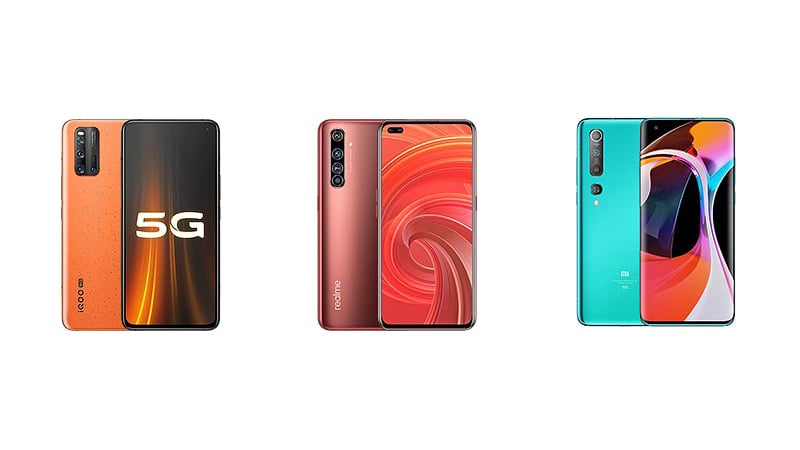Despite 2020 is still in its early months, we already assisted in the launch of several flagship smartphones. And we are not talking only about expensive ones, but also about affordable flagships providing the highest performance at modest prices. Vivo’s brand iQOO just announced the iQOO 3, its latest affordable flagship especially meant for gamers. In this article, we compared its specifications to the ones of the best Chinese affordable flagships launched in 2020: Realme X50 Pro 5G and Xiaomi Mi 10, both announced a few days ago with the support to 5G connectivity.
Vivo iQOO 3 vs Realme X50 Pro vs Xiaomi Mi 10
| Xiaomi Mi 10 | Vivo iQOO 3 | Realme X50 Pro 5G | |
|---|---|---|---|
| DIMENSIONS AND WEIGHT | 162.6 x 74.8 x 9 mm, 208 g | 158.5 x 74.9 x 9.2 mm, 214.5 g | 159 x 74.2 x 9.4 mm, 207 g |
| DISPLAY | 6.67 inches, 1080 x 2340p (Full HD+), Super AMOLED | 6.44 inches, 1080 x 2400p (Full HD+), Super AMOLED | 6.44 inches, 1080 x 2400p (Full HD+), Super AMOLED |
| PROCESSOR | Qualcomm Snapdragon 865, octa-core 2.84 GHz | Qualcomm Snapdragon 865, octa-core 2.84 GHz | Qualcomm Snapdragon 865, octa-core 2.84 GHz |
| MEMORY | 8 GB RAM, 128 GB – 8 GB RAM, 256 GB – 12 GB RAM, 512 GB | 6 GB RAM, 128 GB – 8 GB RAM, 128 GB – 12 GB RAM, 128 GB – 8 GB RAM, 256 GB – 12 GB RAM, 256 GB | 6 GB RAM, 128 GB – 8 GB RAM, 128 GB – 12 GB RAM, 256 GB |
| SOFTWARE | Android 10, MIUI | Android 10, iQOO UI | Android 10, Realme UI |
| CONNECTIVITY | Wi-Fi 802.11 a/b/g/n/ac/ax, Bluetooth 5.1, GPS | Wi-Fi 802.11 a/b/g/n/ac/ax, Bluetooth 5.1, GPS | Wi-Fi 802.11 a/b/g/n/ac/ax, Bluetooth 5.1, GPS |
| CAMERA | Quad 108 + 13 + 2 + 2 MP, f/1.7 + f/2.4 + f/2.4 + f/2.4 20 MP f/2.0 front camera |
Quad 48 + 13 + 13 + 2 MP, f/1.8 + f/2.5 + f/2.2 + f/2.4 16 MP f/2.5 front camera |
Quad 64 + 12 + 8 + 2 MP, f/1.8 + f/2.5 + f/2.3 + f/2.4 Dual 32 + 8 MP f/2.5 and f/2.2 front camera |
| BATTERY | 4780 mAh, fast charging 30W, Fast wireless charging 30W | 4400 mAh, fast charging 55W | 4200 mAh, fast charging 65W |
| ADDITIONAL FEATURES | Dual SIM slot, reverse wireless charging 10W, 5G | Dual SIM slot, optional 5G | Dual SIM slot, 5G |
Design
After the notch, punch-hole displays are becoming the trend in the smartphones market. iQOO 3, Realme X50 Pro 5G and Xiaomi Mi 10 do not need a notch to minimize the bezels since they are equipped with punch-hole displays. The front panel of iQOO 3 and Xiaomi Mi 10 come with a better look because they have a single punch-hole display, while Realme X50 Pro 5G is less minimalistic due to its dual punch-hole, but it offers one more sensor on the front. Overall, Xiaomi Mi 10 has a more attractive design due to its curved screen with the highest screen-to-body ratio, but iQOO 3 should be more sturdy due to Gorilla Glass 6 (front and back). Further, iQOO 3 has shoulder buttons (an interesting feature for gamers), and it is even more compact.
Display
When it comes to the quality of displays, Realme X50 Pro 5G and Xiaomi Mi 10 should be very close. Both offer an AMOLED panel with a high 90 Hz refresh rate, HDR10+, and high DCI P3 coverage, as well as the same resolution. Both high-end panels with great image quality and a high brightness, as well as a high touch sampling rate. Realme X50 Pro 5G and Xiaomi Mi 10 have the most convincing displays, while we would not go for the iQOO 3 since it lacks a high refresh rate, but it retains a 180 Hz touch sensing and a high quality.
Hardware/Software
The strongest point of these handsets is definitely the hardware side: they have the most advanced Qualcomm’s chipset, which is Snapdragon 865 with the support to 5G network thanks to a Snapdragon X55 modem. Note that iQOO 3 provides 5G connectivity only in its most expensive variant with 12 GB of RAM and 256 GB of internal storage. iQOO 3, Realme X50 Pro 5G and Xiaomi Mi 10 all come with the new LPDDR5 RAM and UFS 3.1 native storage, but none of them features expandable storage. Android 10 is preinstalled and customized by proprietary user interfaces. It is a draw when it comes to hardware, software optimization will be the key to success.
Camera
The most advanced camera is mounted on the Xiaomi Mi 10: it has a quad camera setup with a 108 MP main sensor, OIS, an ultrawide sensor, a classic depth sensor, and a dedicated macro camera. Unfortunately, Xiaomi Mi 10 does not have a telephoto sensor (unlike Realme X50 Pro 5G and iQOO 3), but it should provide overall better photo quality. Realme X50 Pro 5G wins the selfie comparison with a dual front camera including an ultrawide lens.
Battery
The battery champion here is the Xiaomi Mi 10 thanks to its huge 4780 mAh battery. It is also the only to feature wireless charging (and it is very fast thanks to a 30W power) and reverse wireless charging.
Price
iQOO 3 starts at €475/$517 in China (the base variant has no 5G), Realme X50 Pro 5G will sell for €599/$652 globally in its base variant, and Xiaomi Mi 10 has a €526/$572 starting price in China, but it will likely cost a lot more globally. Due to its great cameras, bigger battery, wireless charging and more interesting feature, Xiaomi Mi 10 looks like a more complete device. iQOO 3 is the best for gamers, but overall, Realme X50 Pro 5G is more valid and we think it even provides the highest value for money.
- Read More: Xiaomi sold Mi 10 units worth 200 million yuan within a minute in its first sale in China
Vivo iQOO 3 vs Realme X50 Pro vs Xiaomi Mi 10: PRO and CONS
Realme X50 Pro 5G
PROS
- Fastest charging technology
- Good price
- Dual ultrawide front camera
- 5G for the base variant
CONS
- Average cameras
Xiaomi Mi 10
PROS
- Awesome cameras
- Bigger battery
- Great design
- Wireless charging
CONS
- Price
Vivo iQOO 3
PROS
- Very affordable
- More compact
- Bigger battery
- Gorilla Glass 6
CONS
- Standard refresh rate
- 5G only in the top variant








